I had just reached the top of the boulder-strewn talus slope when I heard Kerry yell from 30 meters
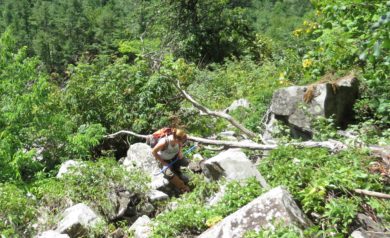
Kerry Monahan searches talus for rattlesnakes. Photo S. Faccio
away, “Hey, there’s a big black fatty over here!” Typically, that’s not a phrase I would consider politically correct, but in our case we were searching for Timber Rattlesnakes, and Kerry had found a black morph adult, possibly a gravid female. I was helping Vermont Fish & Wildlife Department biologist, Doug Blodgett, and field technician, Kerry Monahan, survey state-endangered rattlesnakes. Specifically, on this day, we were searching known birthing sites in an attempt to confirm new litters. In the past week, Doug and Kerry had already confirmed seven new litters in this population—a banner year by all accounts. In most Timber Rattlesnake populations, less than 30 percent of the breeding females give birth in any one year, and typically they only breed every four years or so. At this site, 3 or 4 litters per year is “normal,” so twice that is beyond excellent.
In Vermont, Timber Rattlesnakes are truly living on the edge, both ecologically and culturally. Heavily persecuted over the years by ironically conflicting human interests, their populations have been reduced to just a few remnant den sites near the New York border. Upwards of 40 known populations once ranged across the state from the Champlain Valley to the lower Connecticut River Valley, but they
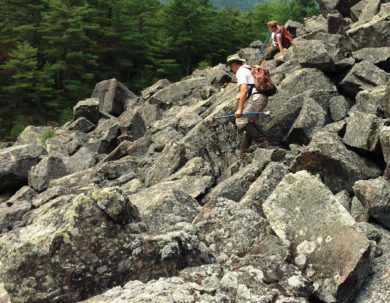
Doug Blodgett and Kerry Monahan do the “rock dance” down a talus slope. Photo S. Faccio
have been decimated, either by those who killed them simply because they feared venomous reptiles, or by those who collected them simply because they desired venomous reptiles, and could make a buck selling them to others with similar desires. Ecologically, rattlesnakes reach the northern limit of their range in Vermont. As ectotherms, they are completely dependent on the sun to reach their ideal body temperature of 89-92 degrees F, and there are only so many days when those conditions occur in northern New England. Without reaching that thermal threshold, basic activities such as feeding, digestion, gestation, mating, and birthing, cannot occur.
Fortunately for Timber Rattlesnakes, it has been a relatively warm, dry summer, so gravid females have had plenty of opportunities to bask on warm rocks—which is about all they do all summer long—allowing the sun to “bake” their developing embryos. Carrying between 6 and 10 young snakes in their tubular bodies doesn’t allow any room for food, even if they had the energy reserves to hunt. Often, gravid females lose as much as 40 percent of their body weight during the 3-month gestation. It literally takes them three to four summers of feeding to recover that lost body fat and be ready to mate again.
By the time Doug and I made our way across the talus to Kerry, looking for snakes as we went, “big black fatty” had taken cover under a car-sized boulder. It could have been a gravid female or a big adult male, Kerry didn’t get a good enough look before it slipped out of sight, but it was another data point and our third rattlesnake of the day. Earlier, and higher up on the talus in a favorite basking area where a large gravid female had been spotted a week or so ago, Doug found a sub-adult snake coiled in a crack between two rocks. We stayed about 3 feet away to avoid disturbing it, and continued to search among the Virginia creeper and numerous shed skins for the big female and hopefully new-born neonates. As Kerry made her way up to where Doug and I were searching, she was at the right angle to see a neonate slip under a rock and out of sight, confirming the female had given birth, and bringing this year’s litter count up to eight! “I’ll buy you a beer for that sighting, Kerry, good job”, said Doug, an offer he had enticed me with earlier in the day that had yet to be earned.
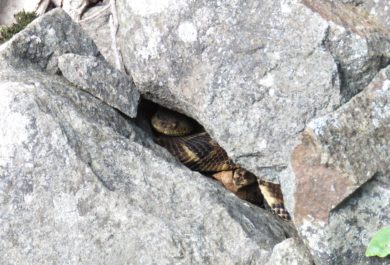
Sub-adult Timber Rattlesnake among talus. Photo S. Faccio
After doing the “rock dance” across our fourth talus slope without another rattlesnake sighting, Doug
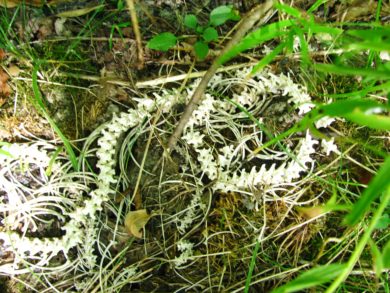
Timber Rattlesnake skeleton. Note neonate skeleton at bottom center. Photo S. Faccio
called it a day. As we began hiking back to the truck, I asked Doug how often they encounter rattlesnakes randomly in the forest, which is where the majority of males and non-breeding females spend the summer hunting mice and chipmunks. “Very rarely—once or twice a summer if we’re lucky.” Just then I said, “What’s this?” There on the forest floor were the bleached bones of a snake skeleton. Dozens of vertebrae littered the ground in a loose figure-8. About the width of a fingernail, they seemed too small for a rattlesnake, but Doug pointed out the 2-3-inch long curved ribs, suggesting a large-bodied adult
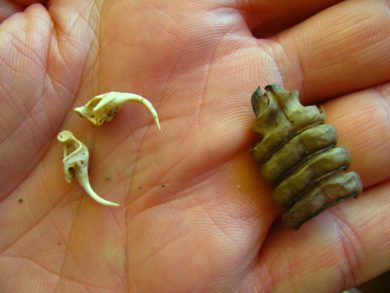
Set of fangs and rattle found among skeleton. Photo S. Faccio
snake. Doug soon found a single fang, and shortly thereafter I found the other, along with the rattle, clinching that this was an adult rattlesnake. As we pondered its demise, we noticed that a tiny skeleton of a neonate was also present—this was apparently a gravid female that had either been depredated (possibly by a raptor or a bobcat) or simply didn’t survive until parturition. Although I didn’t earn a beer for this find, Doug offered me the set of fangs and the rattle instead. Now I’ll drink to that.

RE: Timber rattlesnake in the Conn. valley. About 10 years ago Suzanne Lupien, who later moved to Norwich and was briefly a selectboard member, lived in Cornish, NH. where she briefly collected a timber rattler on a cold morning, bringing it to Montshire Museum, and returning the specimen to its den on her property. Of course this was a NH observation but only just across the river. Yours, Peter Wackell